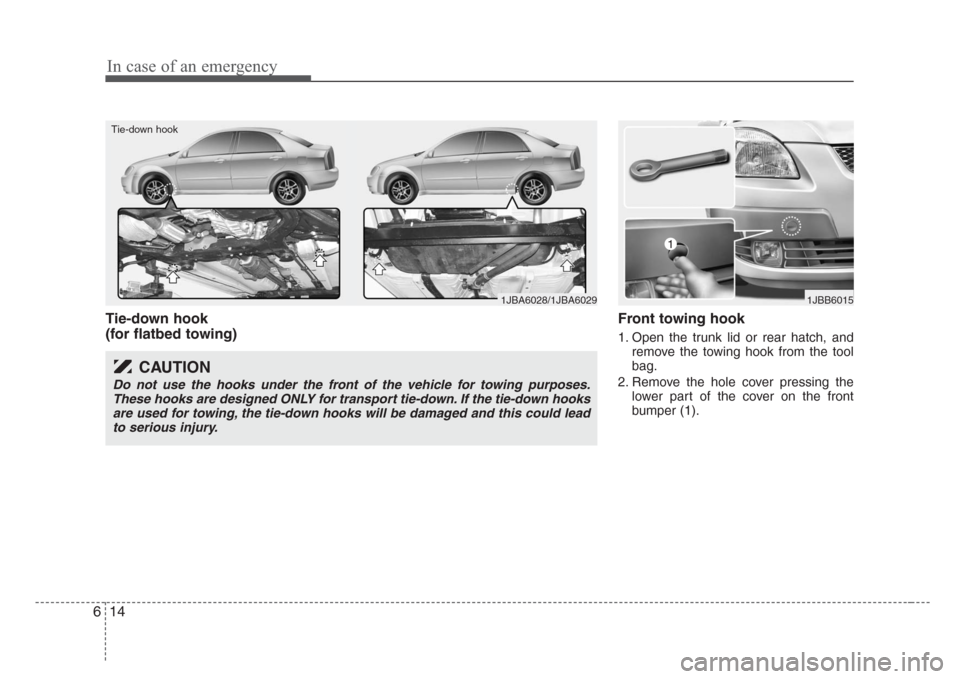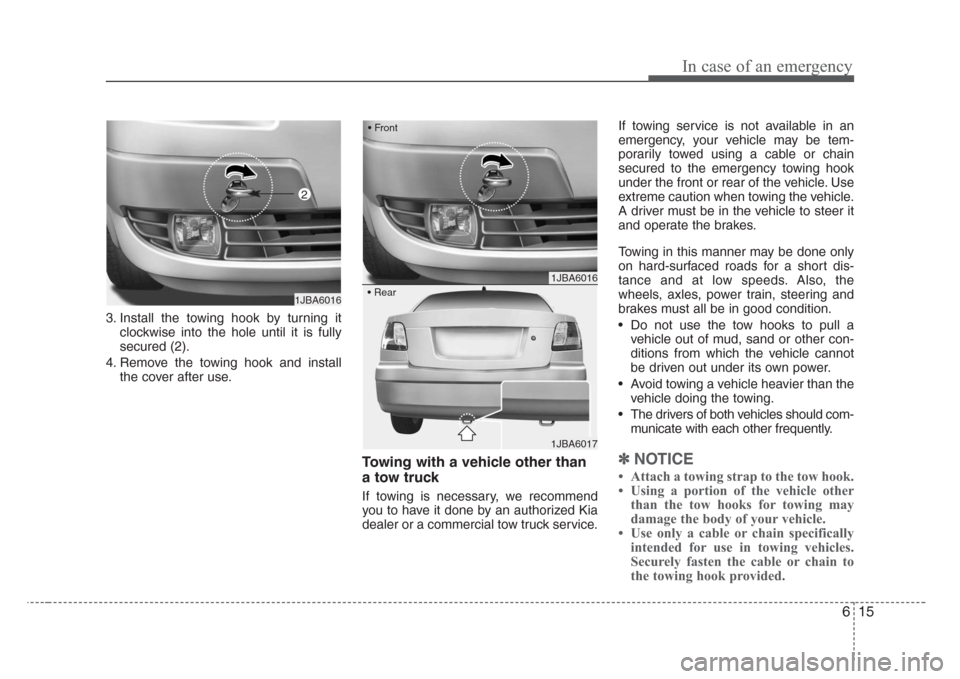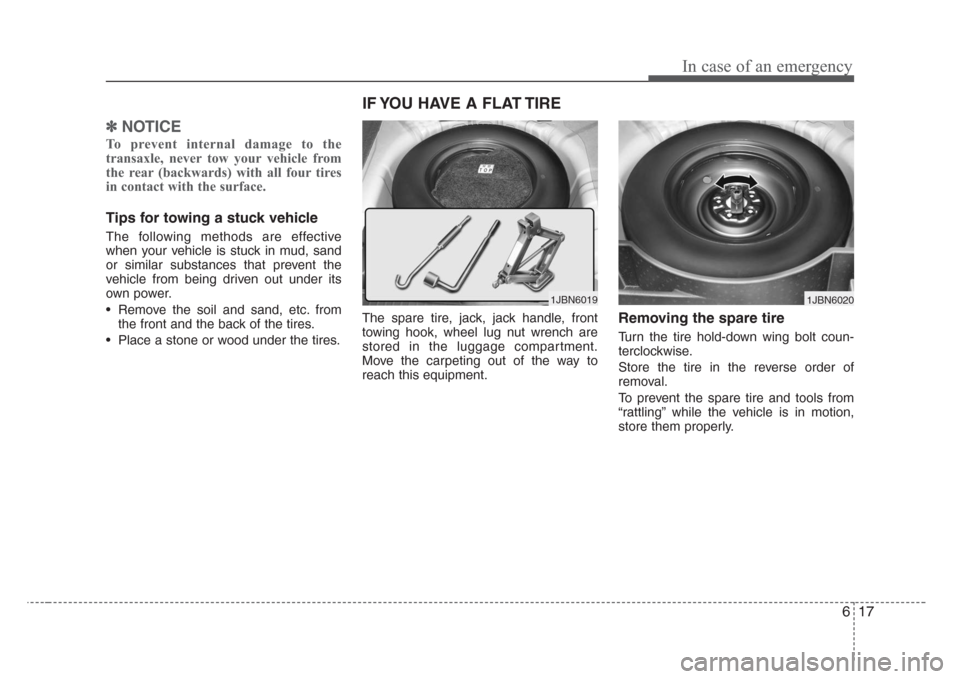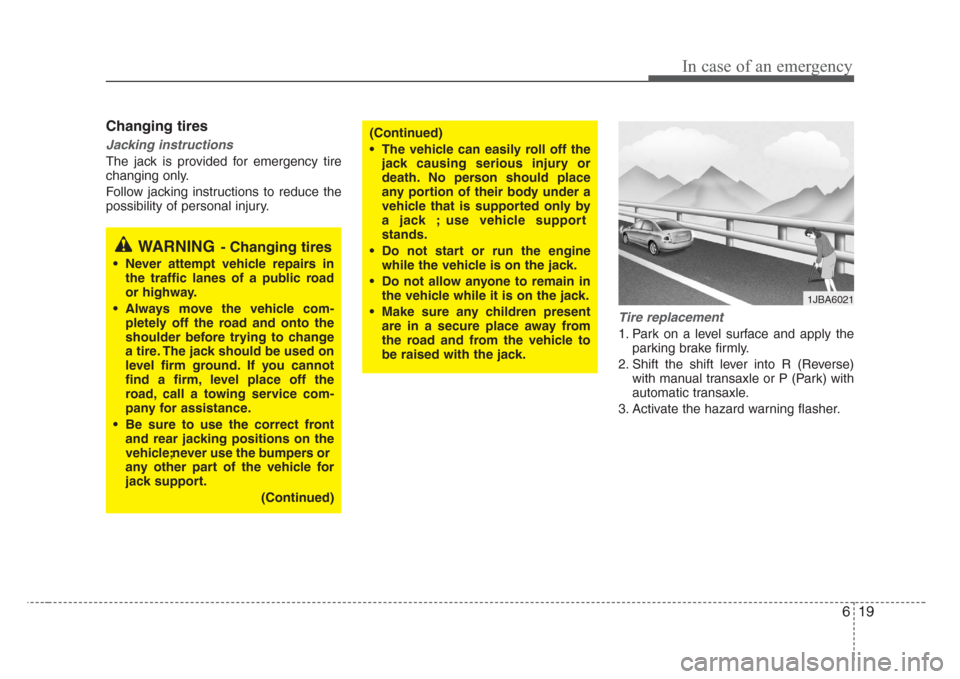2008 KIA Rio towing
[x] Cancel search: towingPage 168 of 219

In case of an emergency
14 6
Tie-down hook
(for flatbed towing)Front towing hook
1. Open the trunk lid or rear hatch, and
remove the towing hook from the tool
bag.
2. Remove the hole cover pressing the
lower part of the cover on the front
bumper (1).
Tie-down hook
1JBA6028/1JBA6029
CAUTION
Do not use the hooks under the front of the vehicle for towing purposes.
These hooks are designed ONLY for transport tie-down. If the tie-down hooks
are used for towing, the tie-down hooks will be damaged and this could lead
to serious injury.
1JBB6015
1
Page 169 of 219

615
In case of an emergency
3. Install the towing hook by turning it
clockwise into the hole until it is fully
secured (2).
4. Remove the towing hook and install
the cover after use.
Towing with a vehicle other than
a tow truck
If towing is necessary, we recommend
you to have it done by an authorized Kia
dealer or a commercial tow truck service.If towing service is not available in an
emergency, your vehicle may be tem-
porarily towed using a cable or chain
secured to the emergency towing hook
under the front or rear of the vehicle. Use
extreme caution when towing the vehicle.
A driver must be in the vehicle to steer it
and operate the brakes.
Towing in this manner may be done only
on hard-surfaced roads for a short dis-
tance and at low speeds. Also, the
wheels, axles, power train, steering and
brakes must all be in good condition.
• Do not use the tow hooks to pull a
vehicle out of mud, sand or other con-
ditions from which the vehicle cannot
be driven out under its own power.
• Avoid towing a vehicle heavier than the
vehicle doing the towing.
• The drivers of both vehicles should com-
municate with each other frequently.
✽
NOTICE
• Attach a towing strap to the tow hook.
• Using a portion of the vehicle other
than the tow hooks for towing may
damage the body of your vehicle.
• Use only a cable or chain specifically
intended for use in towing vehicles.
Securely fasten the cable or chain to
the towing hook provided.
1JBA6016
2
1JBA6016 • Front
1JBA6017 • Rear
Page 170 of 219

In case of an emergency
16 6
• Before emergency towing, check that
the hook is not broken or damaged.
• Fasten the towing cable or chain
securely to the hook.
• Do not jerk the hook. Apply steady and
even force.
• To avoid damaging the hook, do not
pull from the side or at a vertical angle.
Always pull straight ahead.
• Use a towing strap less than 5m (16
feet) long. Attach a white or red cloth
(about 30cm (12 inches) wide) in the
middle of the strap for easy visibility.
• Drive carefully so that the towing strap
is not loosened during towing.When your vehicle is being towed
by another vehicle other than a tow
truck (in case of an emergency)
• Turn the ignition switch to ACC so the
steering wheel isn’t locked.
• Place the transaxle shift lever in N
(Neutral).
• Release the parking bake.
• Vehicles equipped with automatic
transaxles should not exceed 45 km/h
(28 mph) and should not be towed
more than 80 km (50 miles).
• Vehicles equipped with manual
transaxle should not be towed in
excess of 88 km/h (55 mph) and
should not be towed more than 645 km
(400 miles).
• Press the brake pedal with more force
than normal since you will have
reduced brake performance.
• More steering effort will be required
because the power steering system
will be disabled.
• If you are driving down a long hill, the
brakes may overheat and brake per-
formance will be reduced. Stop often
and let the brakes cool off.
CAUTION
Use extreme caution when towing
the vehicle.
• Avoid sudden starts or erratic
driving maneuvers which would
place excessive stress on the
emergency towing hook and tow-
ing cable or chain. The hook and
towing cable or chain may break
and cause serious injury or dam-
age.
• If the towing vehicle does not move
easily, do not forcibly continue the
towing. Contact an authorized Kia
dealer or a commercial tow truck
service for assistance.
• Tow the vehicle as straight ahead
as possible.
• Keep away from the vehicle dur-
ing towing.1JBA4124
Page 171 of 219

617
In case of an emergency
✽
NOTICE
To prevent internal damage to the
transaxle, never tow your vehicle from
the rear (backwards) with all four tires
in contact with the surface.
Tips for towing a stuck vehicle
The following methods are effective
when your vehicle is stuck in mud, sand
or similar substances that prevent the
vehicle from being driven out under its
own power.
• Remove the soil and sand, etc. from
the front and the back of the tires.
• Place a stone or wood under the tires.The spare tire, jack, jack handle, front
towing hook, wheel lug nut wrench are
stored in the luggage compartment.
Move the carpeting out of the way to
reach this equipment.
Removing the spare tire
Turn the tire hold-down wing bolt coun-
terclockwise.
Store the tire in the reverse order of
removal.
To prevent the spare tire and tools from
“rattling” while the vehicle is in motion,
store them properly.
IF YOU HAVE A FLAT TIRE
1JBN60191JBN6020
Page 173 of 219

619
In case of an emergency
Changing tires
Jacking instructions
The jack is provided for emergency tire
changing only.
Follow jacking instructions to reduce the
possibility of personal injury.
Tire replacement
1. Park on a level surface and apply the
parking brake firmly.
2. Shift the shift lever into R (Reverse)
with manual transaxle or P (Park) with
automatic transaxle.
3. Activate the hazard warning flasher.
WARNING- Changing tires
• Never attempt vehicle repairs in
the traffic lanes of a public road
or highway.
•Always move the vehicle com-
pletely off the road and onto the
shoulder before trying to change
a tire. The jack should be used on
level firm ground. If you cannot
find a firm, level place off the
road, call a towing service com-
pany for assistance.
• Be sure to use the correct front
and rear jacking positions on the
vehicle;never use the bumpers or
any other part of the vehicle for
jack support.
(Continued)
(Continued)
• The vehicle can easily roll off the
jack causing serious injury or
death. No person should place
any portion of their body under a
vehicle that is supported only by
a jack ; use vehicle support
stands.
• Do not start or run the engine
while the vehicle is on the jack.
• Do not allow anyone to remain in
the vehicle while it is on the jack.
• Make sure any children present
are in a secure place away from
the road and from the vehicle to
be raised with the jack.
1JBA6021
Page 219 of 219

93
Index
Keys ·················································································3-2
Label information ··························································5-10
Lighting··········································································4-23
Lubricant specifications ·················································7-32
Lubricants and fluids ·····················································7-16
Luggage net ···································································3-78
Maintenance schedule······················································7-3
Maintenance services ·······················································7-2
Manual transaxle······························································4-4
Mirrors ···········································································3-68
Overheating······································································6-2
Overloading ·····································································5-9
Owner maintenance ·························································7-7
Power steering ·······························································7-14
Remote keyless entry ·······················································3-3
Road warning ···································································6-2Safety belts·····································································3-27
Seat·················································································3-17
Special driving conditions ···············································5-6
Specifications ···································································8-2
Starting the engine ···························································4-3
Steering wheel································································4-14
Storage compartment ·····················································3-72
Suggestions for economical operation·····························5-5
Sunroof···········································································3-76
Theft-alarm system ··························································3-5
Tires and wheels ····························································7-23
Towing ···········································································6-12
Trailer towing ··································································5-9
Trunk ··············································································3-62
Vehicle break-in process ··················································1-2
Warnings and indicators ················································4-19
Windows ········································································3-14
Windshield defrosting and defogging····························4-37
Wiper blades ··································································7-19
Wipers and washers ·······················································4-26
K
L
M
O
P
R
S
W
T
V